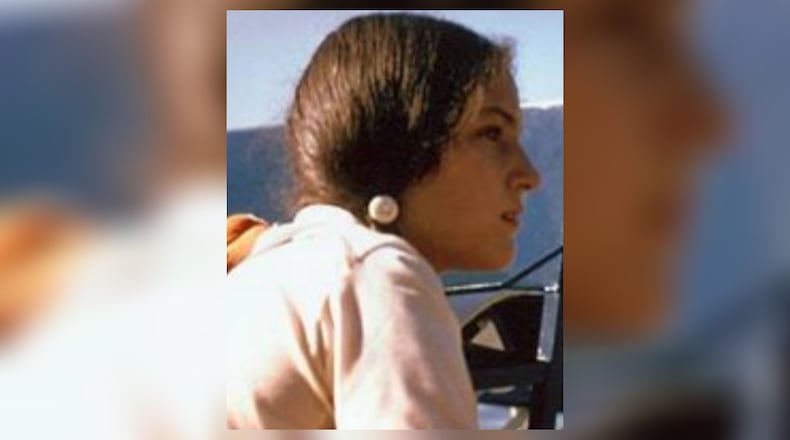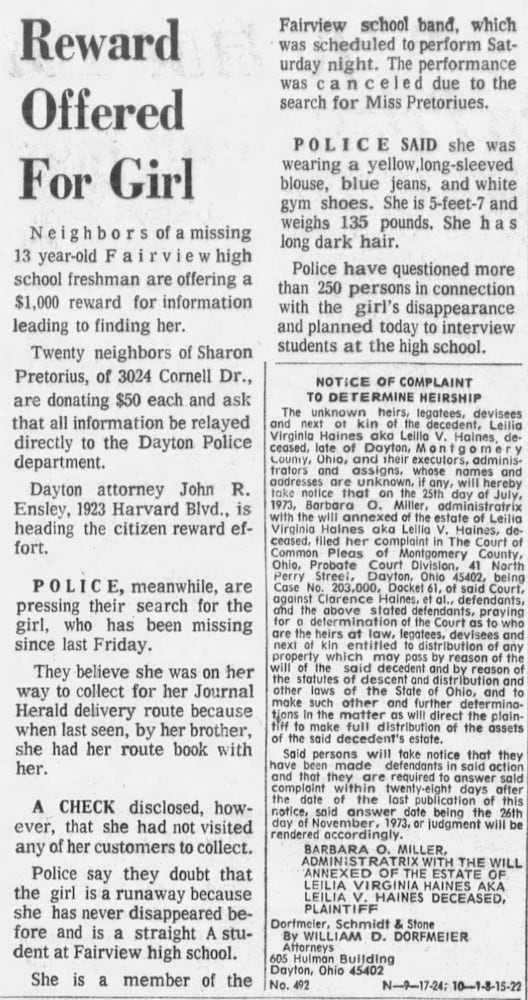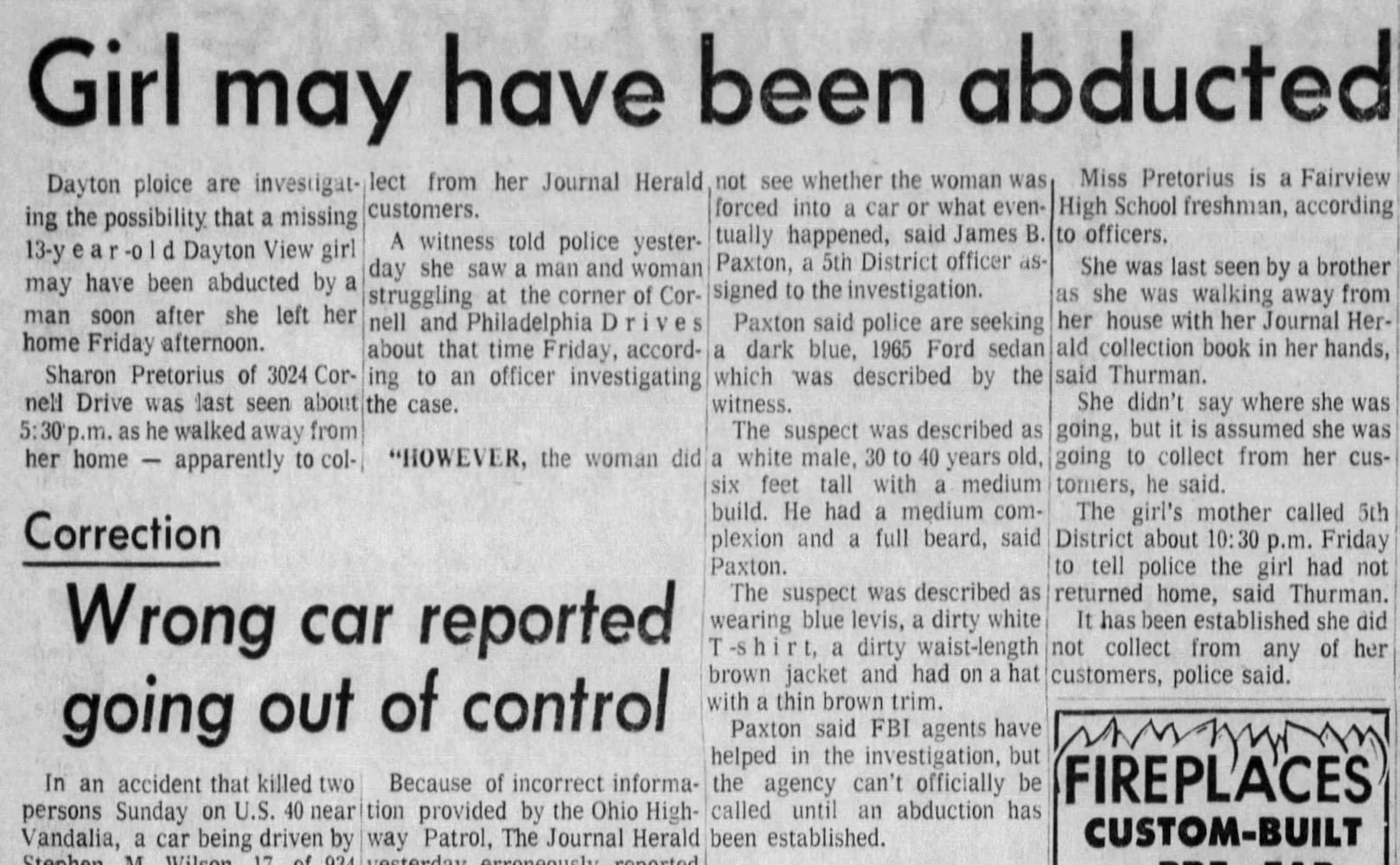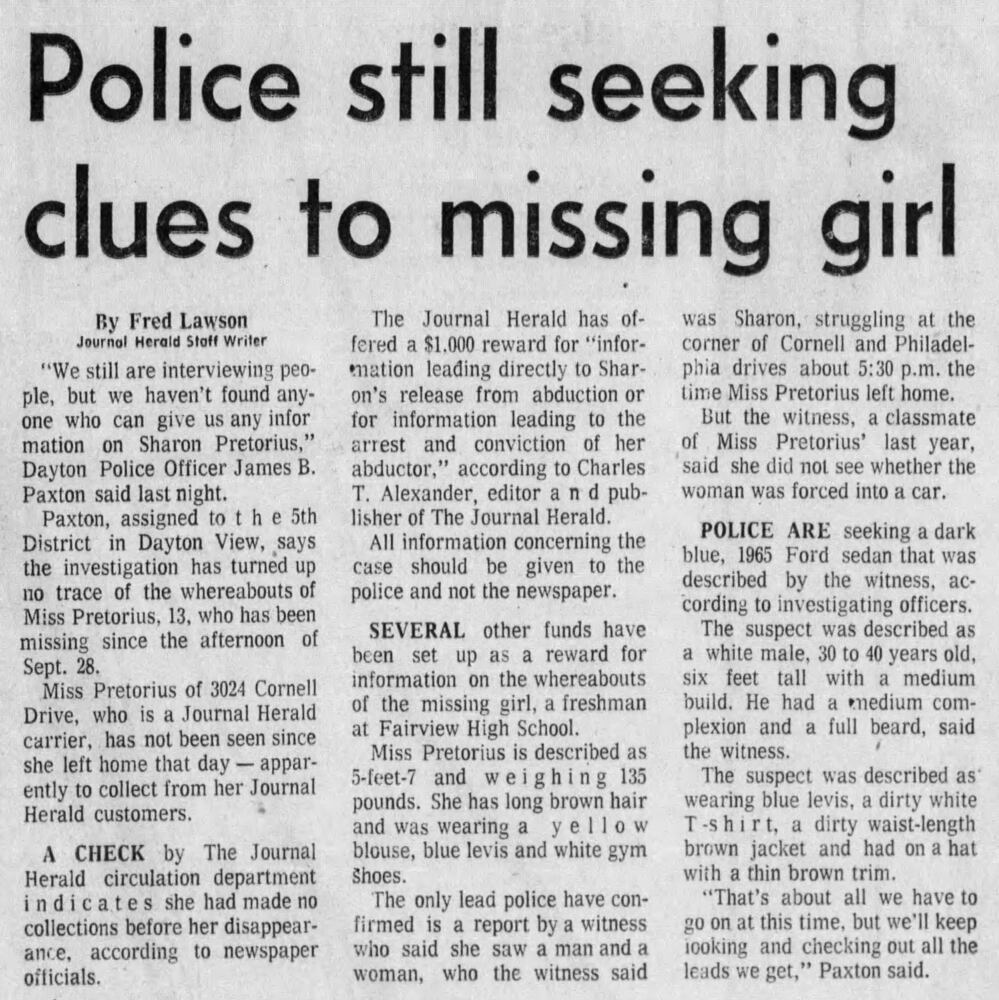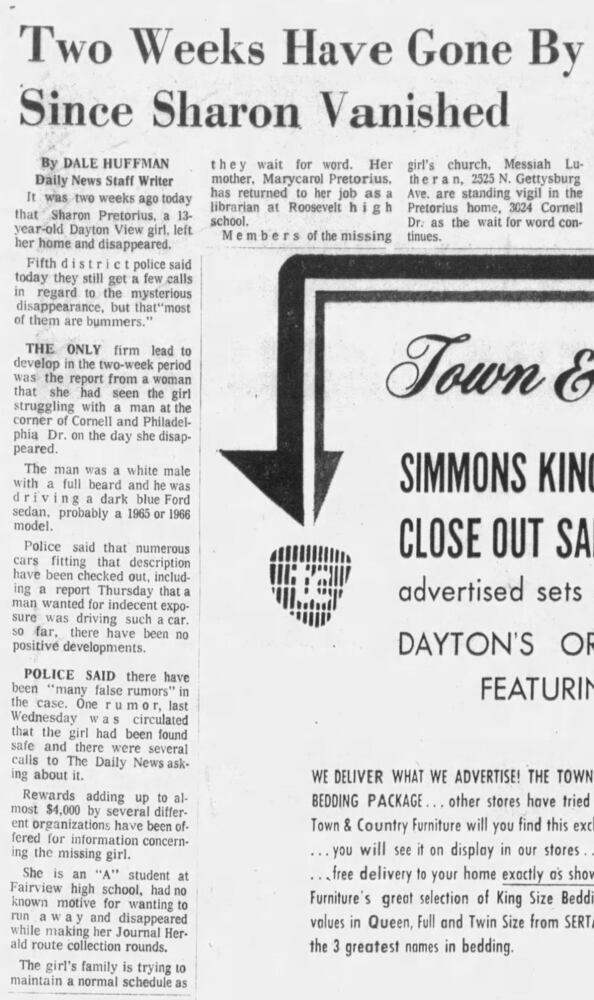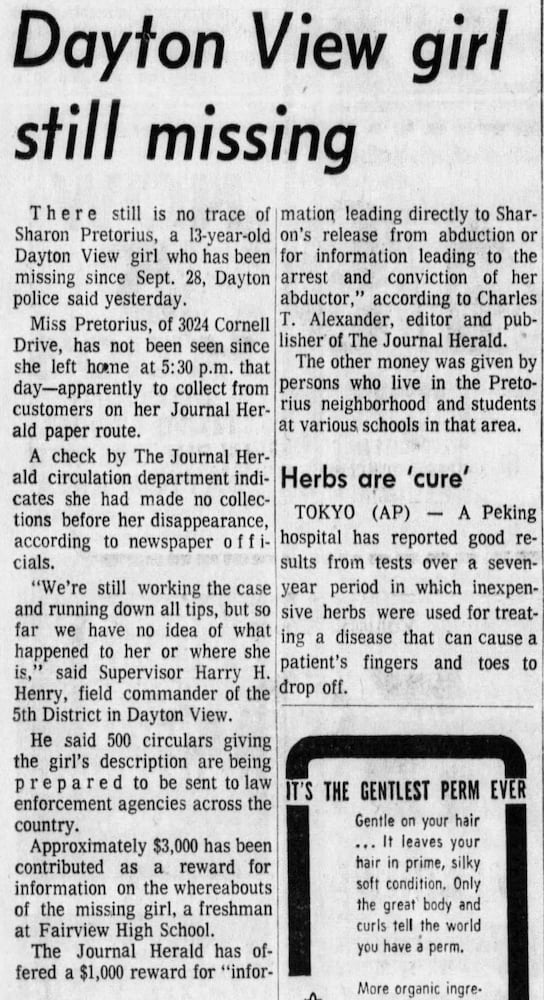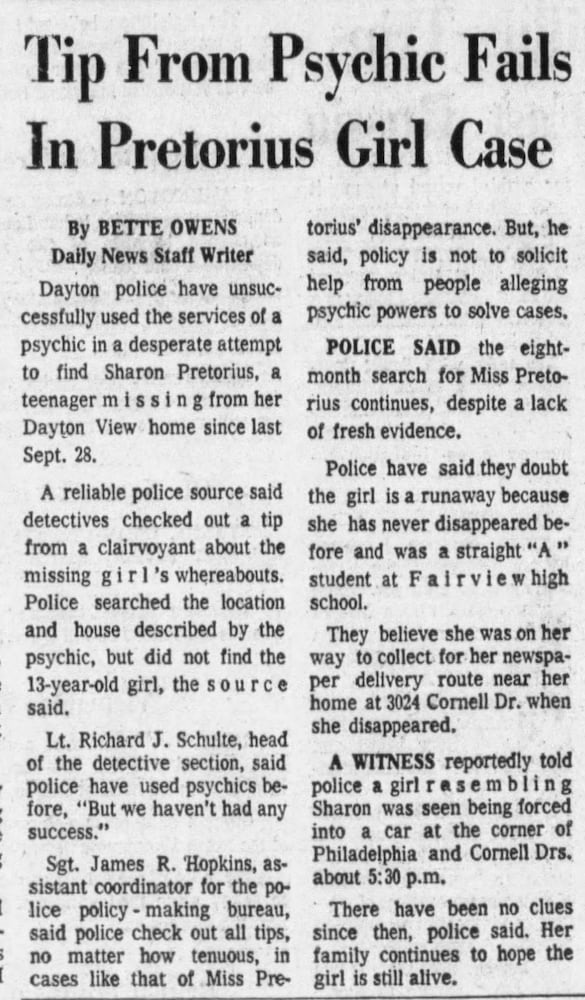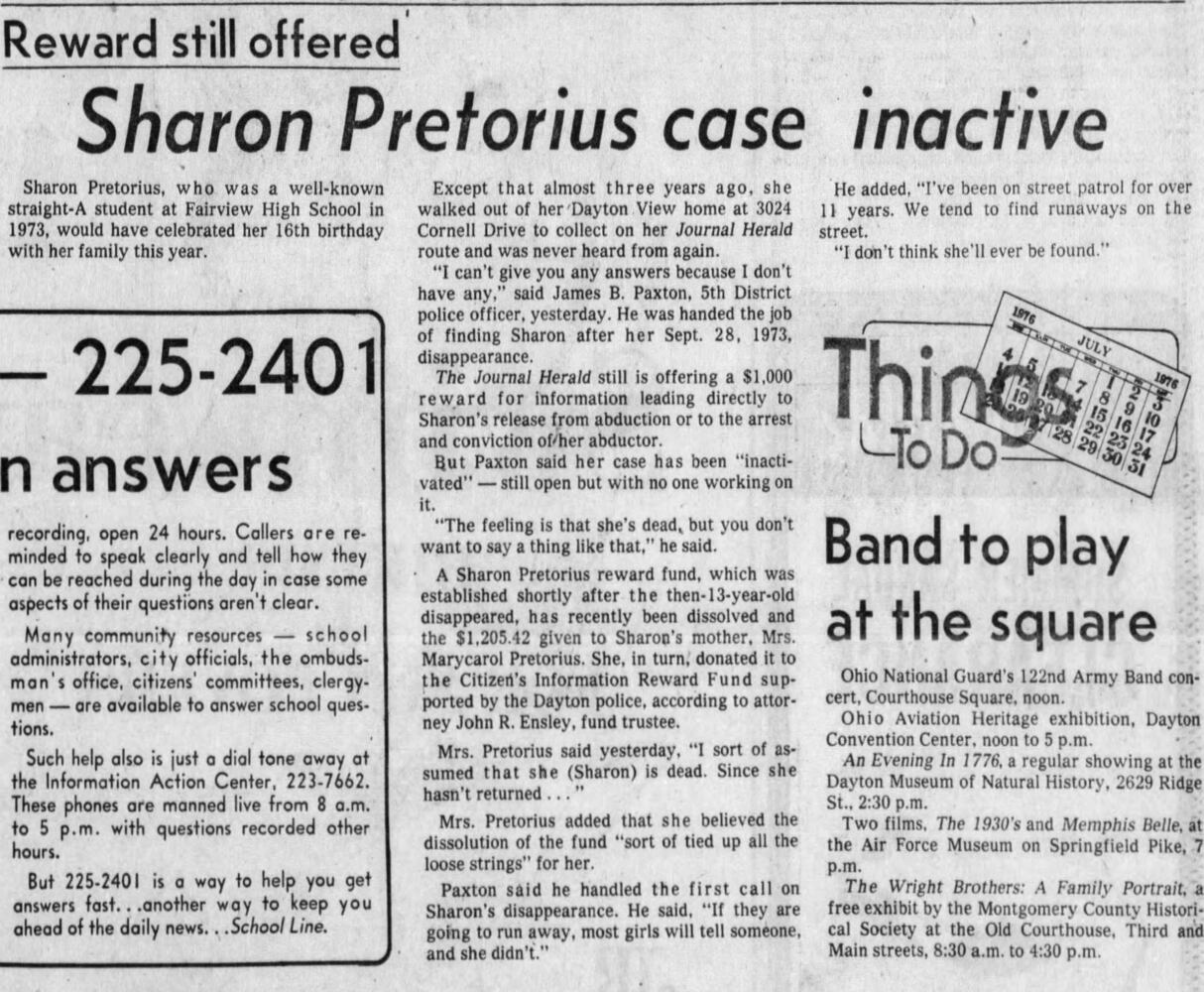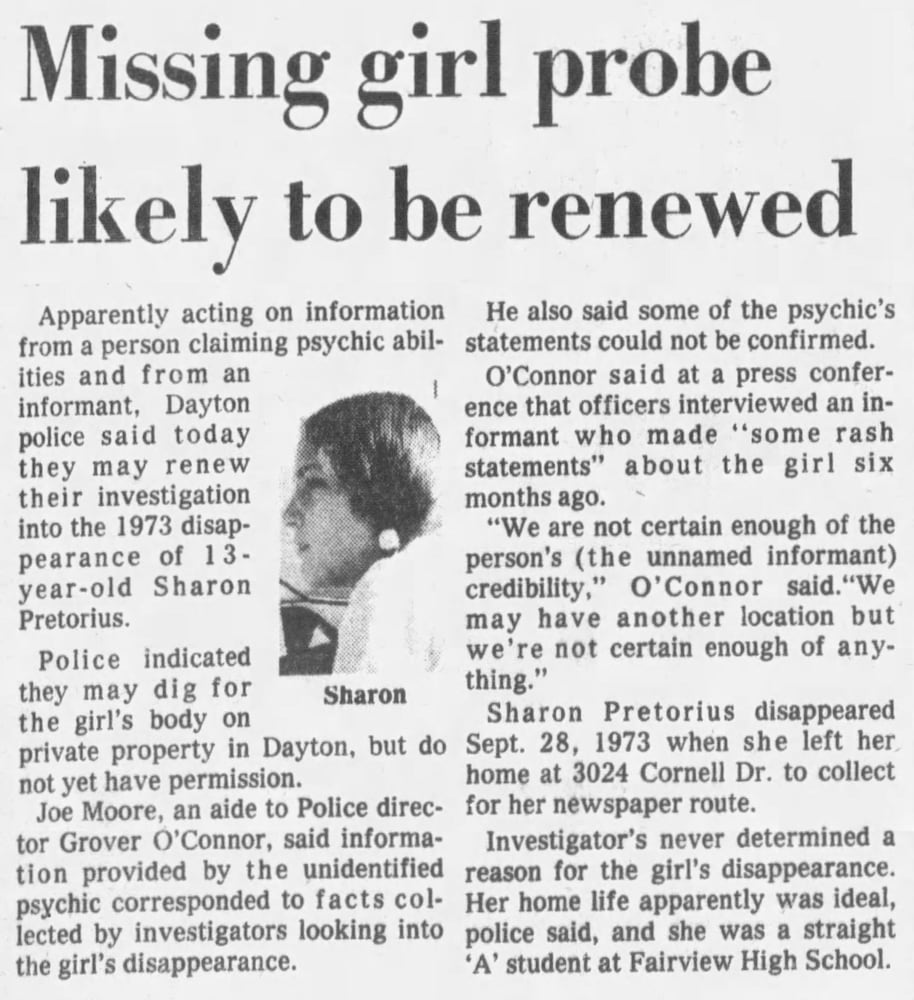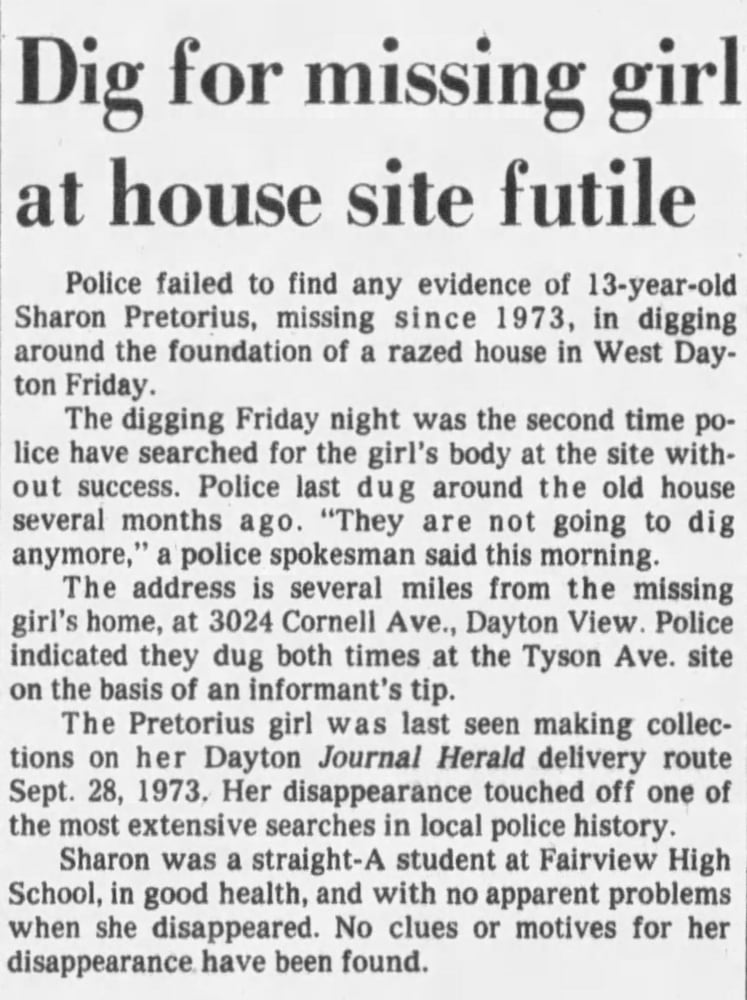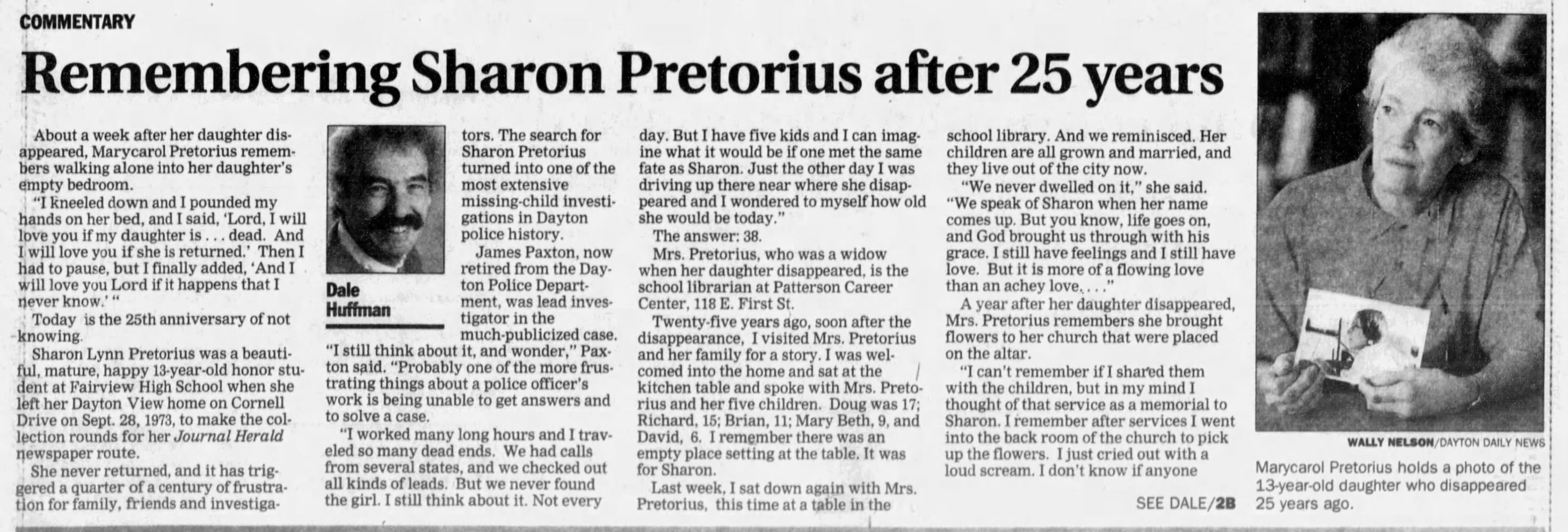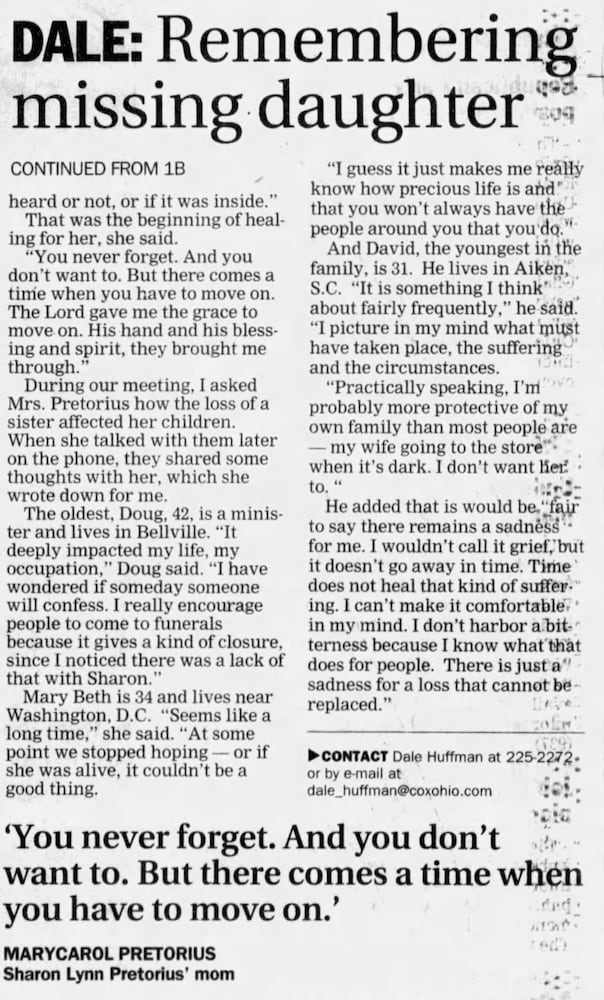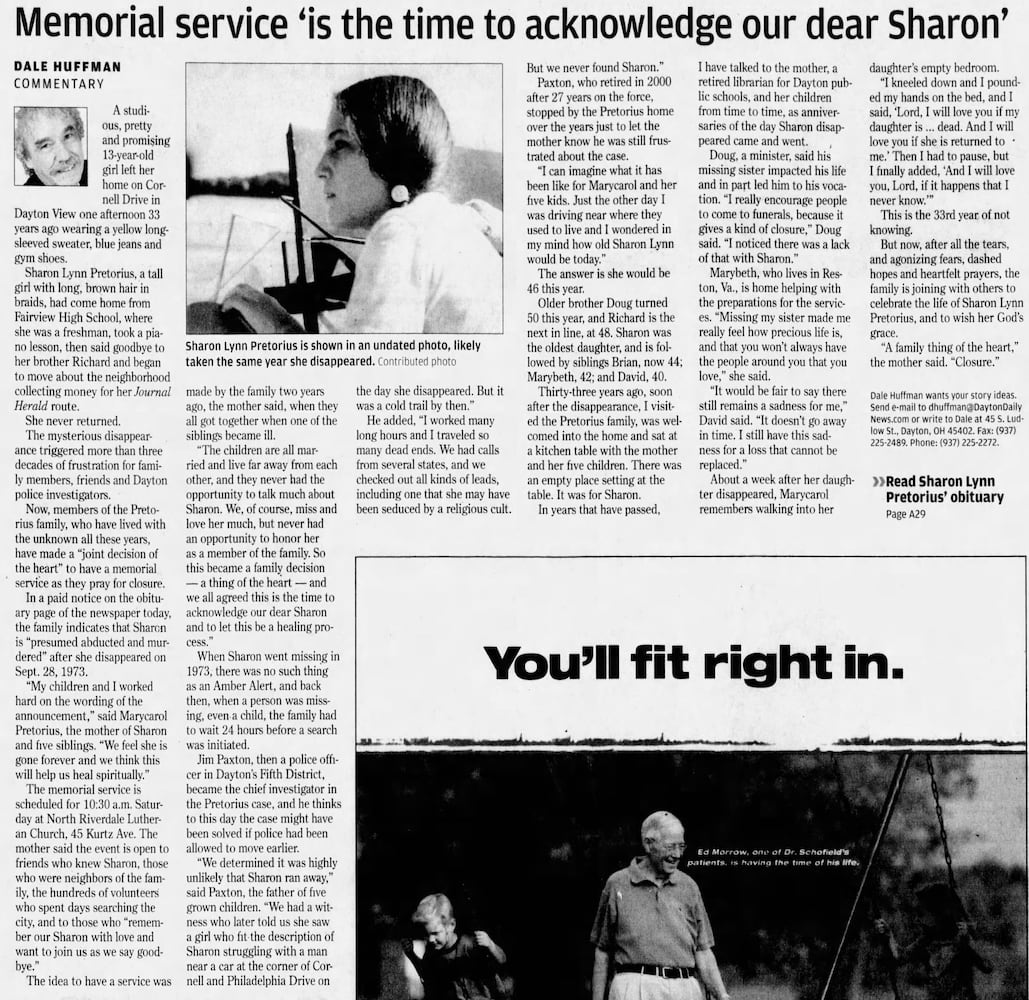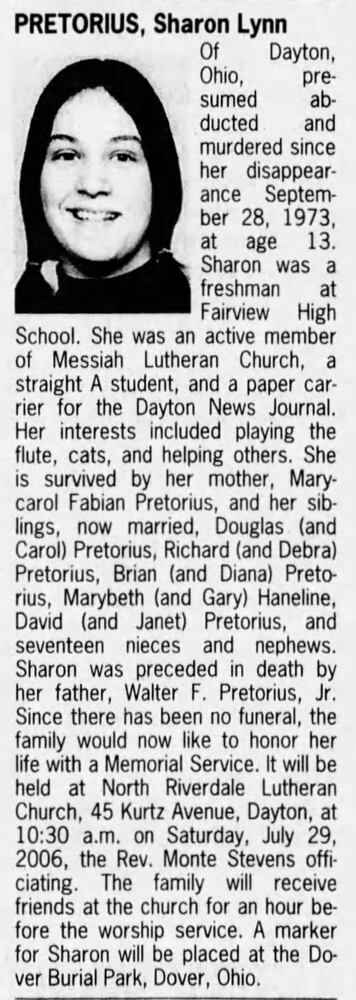The podcast’s title is a reference to decks of cards at prisons and jails that depict missing people and victims in cold cases in the hope that one of the people using the cards might recognize someone and help solve the case.
In Ohio, these cards are produced by a nonprofit called UCanSpeakForMe, which has produced three versions of the cards.
Sharon Pretorius
Sharon was a freshman at Fairview High School after skipping eighth grade at Cornell Heights School and was an “A” student. She was the daughter of a school librarian, stood 5 feet 7 inches tall, and wore her long brown hair in pigtails.
She played flute in the band, and was even pictured in May 1973 playing the flute in a Dayton Daily News supplement page intended for young readers under an article titled “Which Band Instrument Would You Like to Play?”
She was last seen by her family at about 5-5:30 p.m. on Friday, Sept. 28, 1973 at their home in the 3000 block of Cornell Drive.
A collection of Dayton Daily News and Journal Herald articles covering Sharon’s disappearance and its aftermath are included at the bottom of this story.
The disappearance
She was reportedly last seen by a brother walking away from her house with her Journal Herald collection book in her hands, though a later check by the Journal Herald circulation department found that she hadn’t visited any of her customers. In 2003, the Dayton Daily News reported that the first customer lived just across the street.
Her mother, Marycarol Pretorius, called police to say the girl hadn’t come home at about 10:30 that night. Investigators decided that Sharon was unlikely to have run away, telling reporters that it was because she was an “A” student and had never tried to run away before.
The search began for the girl, later called one of the most extensive searches in Dayton police history, and Officer James B. Paxton was put in charge.
The search
By Sunday, Paxton and the 5th District Dayton Police had questioned about 250 people in the lower Dayton View area, between Wolf Creek, Gettysburg Avenue and Salem Avenue, according to police at the time. Police told reporters that they also planned to interview students at the high school.
The Fairview High School band canceled a performance on that Saturday due to the search.
By Monday, neighbors had put together a $1,000 reward for information leading to Sharon being found. Total reward funds rose to almost $4,000 by Thursday, including $1,000 from the Dayton Journal Herald and other funds from neighbors, students at Fairview and Roosevelt high schools and Cornell Height Middle School.
The search was also bolstered by members of the Pretorius’ congregation at the Messiah Lutheran Church on Gettysburg Avenue. In 2003, Marlene Parrott of Englewood remembered, “All the men who were able went out and canvassed the neighborhood, while the women stayed with Marycarol (Pretorius) at the house and talked.”
The most solid lead, according to police, came from witness who told police on Monday that she saw a man and Sharon struggling at the corner of Cornell and Philadelphia drives at about the right time on Friday. However, Paxton said that the witness didn’t see whether Sharon was forced into a car or what eventually happened. Later reporting said that the witness was a former classmate of Sharon’s
That led to one possible suspect, described as a white man, about 30 to 40 years old, who stood 6 feet tall and had a medium build and complexion with a full beard. He was wearing blue jeans, a dirty white t-shirt, a dirty brown waist-length jacket and had on a hat with a thin brown trim, according to reporting at the time. The man was reportedly driving a dark blue 1965 or 1966 Ford sedan.
On Friday police told reporters that they had checked out numerous cars fitting that description but didn’t find anything positive.
The search continued to expand without success. In 1976, the case was labeled as inactive, meaning still open but with nobody working on it, with Marycarol Pretorius donating the $1,205.42 from the reward fund to the Citizens Information Reward Fund supported by the Dayton Police.
At the time, Paxton said, “I’ve been on street patrol for over 11 years. We tend to find runaways on the street. I don’t think she’ll ever be found.”
Leads and dead ends
In 1998, ahead of the 25th anniversary of Sharon’s disappearance, columnist Dale Huffman spoke to Paxton, who by then had retired from the Dayton Police Department.
In the column, Paxton spoke about the case, saying, “I worked many long hours and I traveled so many dead ends. We had calls from several states, and we checked out all kinds of leads. But we never found the girl.”
Two such tips even came from people claiming to be psychics, one in 1974 that led to the search of a house and another in 1977 where information from a person claiming psychic abilities and another informant led police to possibly dig on private property for Sharon’s body.
One former Dayton police detective later said that she believed that the early investigation was hampered by policies and attitudes about missing children at the time. In a 2003 article, Carol Huber, who said she was working as a youth worker with the YMCA Youth Outreach program when Sharon went missing, worked with Paxton and others out of Dayton’s 5th District to gather clues. She retired as a fraud detective in 2000.
“The assumption was that she was a runaway even though Jim Paxton and those guys handled it differently,” she said. “They were so constrained by the norms of the day, and he was fighting those norms. But the standard response impacted the outcome.”
In addition, Huber said that at the time police waited 24 hours before starting their search.
Huber wondered whether better investigative tools would have helped, saying, “Had this happened now, the possibilities would have been greater. The world was so different then. With Amber Alert, information comes in, and you can shut a city down. There is so much more awareness.”
Continuing effects
For Sharon’s family, her disappearance was an unresolved hurt.
Huffman spoke to Marycarol Pretorius in 1998, who spoke about dealing with the pain of not knowing what happened to her daughter. She said about a year after he daughter disappeared, she brought flowers to her church that were placed on the altar.
“I can’t remember if I shared them with the children,” she said, “but in my mind I thought of that service as a memorial to Sharon. I remember after services I went into the back room of the church to pick up the flowers. I just cried out with a loud scream. I don’t know if anyone heard or not, or if it was inside.” However, she said that was the beginning of healing for her.
Sharon’s youngest brother David, said that it would be “fair to say there remains a sadness for me. I wouldn’t call it grief, but it doesn’t go away in time. Time does not heal that kind of suffering. I can’t make it comfortable in my mind. I don’t harbor a bitterness because I know what that does for people. There is just a sadness for a loss that cannot be replaced.”
Closure, of a sort
Finally, in 2006, the family decided to say goodbye.
“We have lived too long with this, the not knowing,” Marycarol Pretorius said to Huffman. “The five children came together in love and decided as a family that we needed to face reality. It’s hard to say, but we must face it. Our Sharon is gone forever.”
They held a memorial service at North Riverdale Lutheran Church in July 2006.
Paxton, whose filed on Sharon Pretorius was “thick with dead-end leads,” Huffman wrote, said, “I always had hopes that we might find out one day. It has been pure agony for this wonderful mother and her children. I think it is good for them to go for closure.”
They also posted an obituary for Sharon in the Dayton Daily News, saying she was “presumed abducted and murdered since her disappearance September 28, 1973.” A burial marker was placed for her at the Dover Burial Park in Dover, Ohio.
New leads
Police have continued to watch for information on Sharon’s disappearance, leading to a search in May 2011 of a five-acre vacant lot at Hoover Avenue and Guenther Street using heavy equipment, cadaver dogs and ground-penetrating laser equipment.
The search prompted the family to offer a $2,500 reward for information leading them to her remains.
At the time, Dayton Detective Patricia Tackett said, “We believe there are people with information. Those involved may be deceased, but their families may have information.”
“Only people’s memories can help us now,” Art Fabian, Sharon’s uncle, said at a news conference.
Unfortunately, Sharon’s mother would not live to find out what happened to her daughter. Marycarol Pretorius died on June 24, 2021, according to her obituary.
Today, the Ohio Attorney General’s Office continues to list Sharon on its Missing Persons page along with a image of what she may look like at 50 years old, pictured below.
If you have any information about the disappearance of Sharon Pretorius, you can contact the Dayton Police Department at 937-333-2677, or you can leave an anonymous tip with Miami Valley Crime Stoppers at 937-222-7867 or via their website.
About the Author
